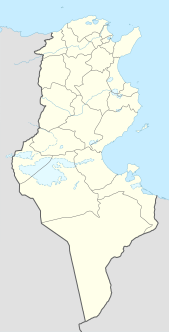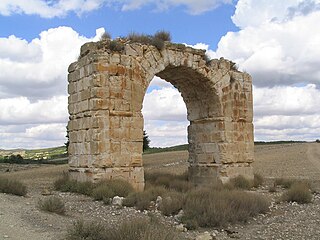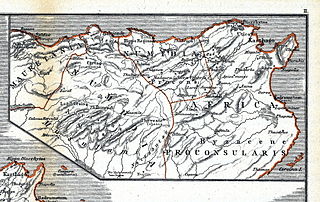Henchir-El-Djemel Vicus Turris | |
|---|---|
 countryside near Henchir-El-Djemel | |
| Coordinates: 34°44′N10°46′E / 34.733°N 10.767°E Coordinates: 34°44′N10°46′E / 34.733°N 10.767°E | |
| Country | |
| Governorates | Sfax Governorate |
| Elevation | 17 m (57 ft) |
Vicus Turris is a former Roman and Byzantine town of Africa and a titular see of the Roman Catholic Church.

The Roman Empire was the post-Roman Republic period of the ancient Roman civilization. Ruled by emperors, it had large territorial holdings around the Mediterranean Sea in Europe, North Africa, the Middle East, and the Caucasus. From the constitutional reforms of Augustus to the military anarchy of the third century, the Empire was a principate ruled from the city of Rome. The Roman Empire was then ruled by multiple emperors and divided in a Western Roman Empire, based in Milan and later Ravenna, and an Eastern Roman Empire, based in Nicomedia and later Constantinople. Rome remained the nominal capital of both parts until 476 AD, when Odoacer deposed Romulus Augustus after capturing Ravenna and the Roman Senate sent the imperial regalia to Constantinople. The fall of the Western Roman Empire to barbarian kings, along with the hellenization of the Eastern Roman Empire into the Byzantine Empire, is conventionally used to mark the end of Ancient Rome and the beginning of the Middle Ages.

Africa Proconsularis was a Roman province on the northwest African coast that was established in 146 BC following the defeat of Carthage in the Third Punic War. It roughly comprised the territory of present-day Tunisia, the northeast of Algeria, and the coast of western Libya along the Gulf of Sirte. The territory was originally inhabited by Berber people, known in Latin as Mauri indigenous to all of North Africa west of Egypt; in the 9th century BC, Phoenicians built settlements along the Mediterranean Sea to facilitate shipping, of which Carthage rose to dominance in the 8th century until its conquest by the Roman Republic.
A titular see in various churches is an episcopal see of a former diocese that no longer functions, sometimes called a "dead diocese".
The town is identified with modern Henchir-El-Djemel, near Sakiet Ezzit in the Gouvernorat of Safaqis, Tunisia (North Africa). Henchir-El-Djemel is located at 34°53'50" N and 10°46'51" E just north of Sfax. It is situated on a wadi, 7 km from the Mediterranean coast with an elevation of 57 meters above sea level. [1] Hennchir el Djemel is also known as Hanshīr al Jamal, and Henchir el Jemel. [2]

A town is a human settlement. Towns are generally larger than villages but smaller than cities, though the criteria to distinguish them vary considerably between different parts of the world.

Henchir-El-Djemel, is a village of North Africa, near Sakiet Ezzit in the Gouvernorat of Safaqis, in Tunisia.

Sakiet Ezzit is a town and commune in the Sfax Governorate, Tunisia. Attached administratively to the governorate of Sfax, it is the center of a delegation counting 72 481 inhabitants in 2006 and is a municipality with 44,886 inhabitants in 2004.2 The city itself has a population of 12 613 inhabitants. As of 2004 it had a population of 44,886.












